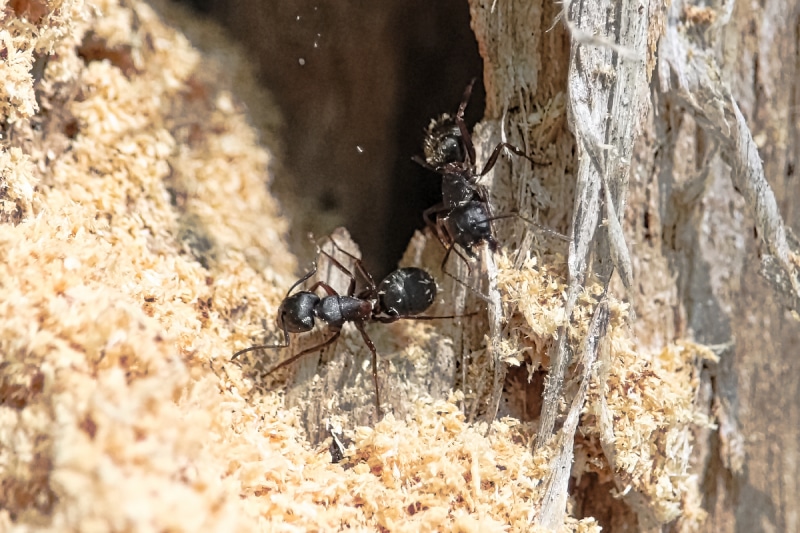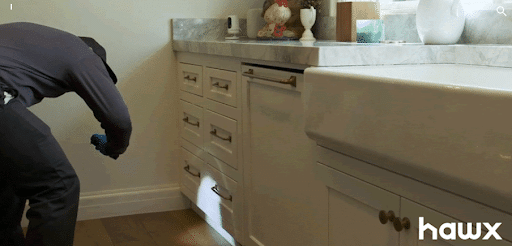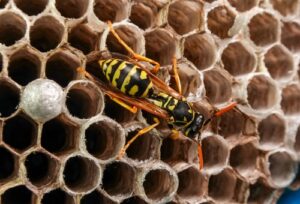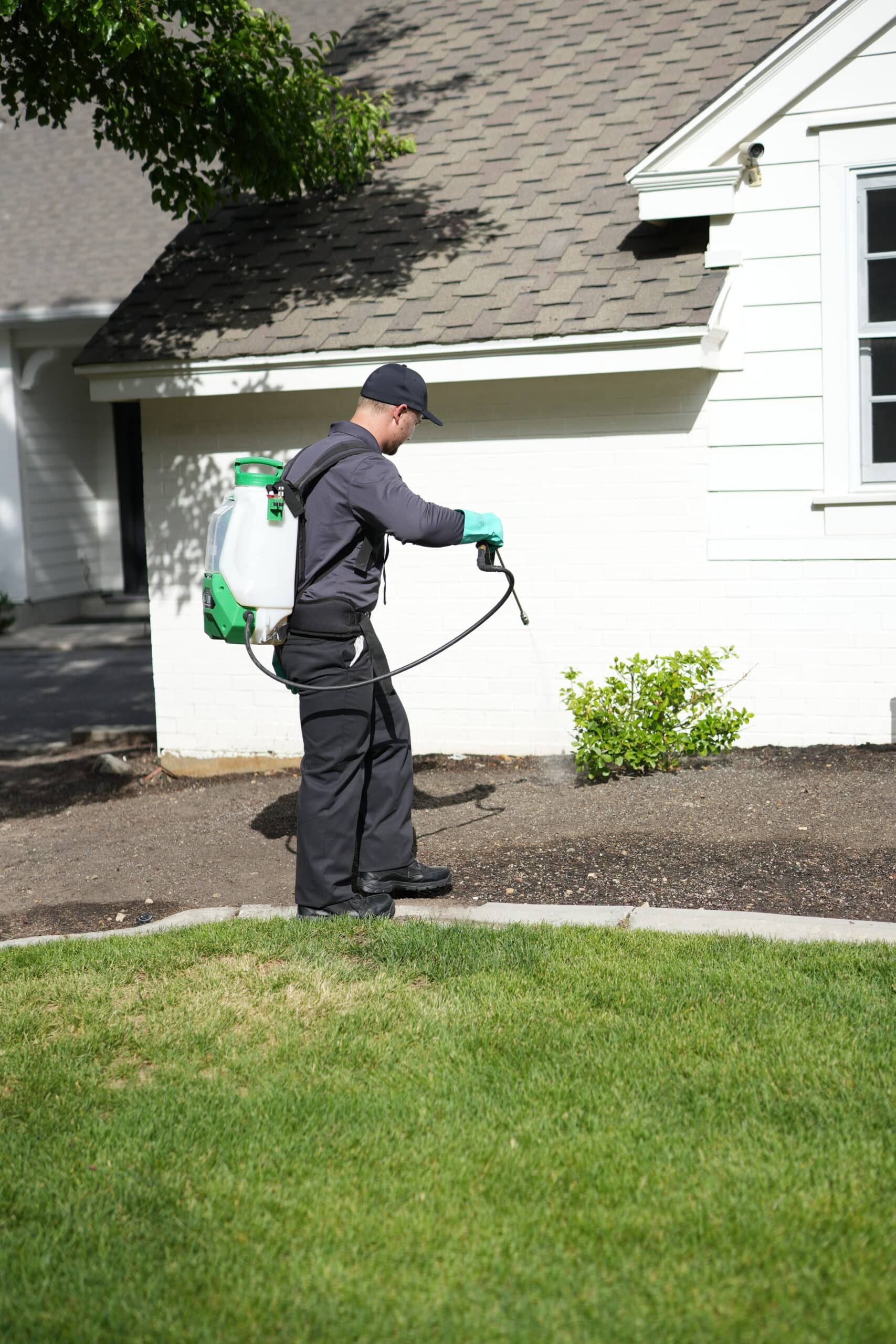Carpenter Ant Facts & Information
Hawx is always reliable. Always innovative.
20,000+ 5-STAR REVIEWS
“Connors Trader went the extra mile to make sure he listened to our needs regarding the ant problem we had.”
- Larry
“He sprayed indoors and out, swept my eaves for spider webs and took care of a couple of wasp nests.”
- Rick
“He even sprayed on my deck, which no one else has done.”
- Sue

Carpenter ants are large, wood-destroying insects that can easily become a major headache for homeowners in many parts of the United States. Although they don’t actually consume wood the way termites do, their habit of tunneling through damp or decaying wood can lead to structural damage if left unchecked.
Let’s look at how to identify carpenter ants, what you can do to prevent them from moving in, and ways to deal with an existing infestation so you can keep your home safe.
Get help with your carpenter ant problems by calling the ant control pros at Hawx Pest Control! Dial (888) 372-9514 today.

Carpenter Ant Identification
Carpenter ants are among the biggest ants you’ll see in or around your home. Most workers measure anywhere from ¼ to ½ inch in length. Here are the main physical features you’ll see in Carpenter Ants:
- Color Variations: Carpenter ants are often black, but some species can have sections of red, brown, or even golden hairs.
- Single Node Waist: A small node (or bump) connects their thorax and abdomen.
- Smooth, Rounded Thorax: Viewed from the side, their thorax is curved rather than ridged.
- Bent Antennae: Like many ant species, carpenter ants have elbowed antennae.
To the untrained eye, they can sometimes be confused with termites. Unlike termites, however, carpenter ants have a pinched waist, elbowed antennae, and—if they have wings—the front pair is typically longer than the back pair.
Common Carpenter Ant Species You May Encounter
- Black Carpenter Ant (Camponotus pennsylvanicus): A classic eastern species that builds large colonies and often targets water-damaged wood.
- Florida Carpenter Ant (Camponotus floridanus): Primarily found in and around Florida, these ants can give a sharp bite if disturbed.
- Red Carpenter Ant (Camponotus chromaiodes): Recognizable by its contrasting red-and-black body, frequently seen in the Southeast.
- Western Black Carpenter Ant (Camponotus modoc): A solid black ant more common in western and southwestern states, sometimes sporting lighter hairs.
- Camponotus vicinus: Widespread along the West Coast and known for its varied coloring, from reddish-brown to nearly all black.
- Camponotus clarithorax: Found along the Pacific Coast and as far south as the Baja Peninsula, occasionally spotted farther east.
What Attracts Carpenter Ants to Your Home?
Carpenter ants rarely invade without reason. They’re drawn to spaces that provide two key resources: moisture and soft or compromised wood. Any damp or decaying wood—such as a rotting window frame or a tree stump close to your foundation—can become an appealing nest site. Leaky pipes, poor ventilation, and water damage in walls or crawl spaces can also create the perfect environment for carpenter ants to settle in, along with overhanging tree limbs that touch your roof or siding.
Signs of a Carpenter Ant Infestation
Worried you might have carpenter ants? Here’s what to look for:
- Sawdust-like Material (Frass): Carpenter ants discard wood shavings and dead insects from their galleries, often leaving small piles near entry holes or inside wall voids.
- Rustling Sounds: Listen for faint crackling or rustling noises in walls, especially at night when the colony is most active.
- Trails of Large Ants: If you spot unusually big ants foraging in your kitchen or bathroom, they may be carpenter ants on the hunt for food or water.
- Winged Ants Indoors: If a colony has matured inside your home, swarmers (reproductive ants with wings) may emerge—a major sign of an established nest.

“Carpenter ants are wood-damaging insects. They do not consume wood like a termite would; they excavate chambers and cause a nuisance to homeowners. They can certainly cause superficial damage that looks like drywood termites and you may see big holes opening up in your wood. ”
Vice President of Technical & Training Services, Entomologist
What Damage Can Carpenter Ants Cause?
Although they won’t eat your walls like termites, carpenter ants carve out tunnels and chambers within wood to expand their nest. Over time, this destructive process can weaken structural elements, damage insulation, and lead to unsightly holes in siding or window frames. The damage can become extensive if left unchecked, so it’s crucial to take action early.
How Do You Get Rid of Carpenter Ants?
Eliminating carpenter ants often means addressing both the current infestation and any conducive conditions that attracted them in the first place. Here are some useful tips:
- Locate the Nest: Look for frass piles, visible ants coming and going, or damp wooden areas they might be using.
- Repair Moisture Issues: Fix leaks, improve ventilation, and remove any rotting wood inside or around your home.
- Direct Treatments: Drilling small holes to apply insecticide dusts or foams directly into the nest can be effective. Baiting can also help if the ants are actively foraging for food.
- Seal Entry Points: Use caulk or weather stripping around doors, windows, and utility lines to block off easy entry routes.
- Professional Pest Control: The most effective approach to getting rid of carpenter ants is to let experts handle it. Experienced pest control technicians have specialized tools to pinpoint and treat hidden nests and create barriers that help prevent future infestations.
Let Hawx Handle Your Carpenter Ant Problem
Carpenter ants are resourceful, persistent, and more than a little destructive if left to tunnel freely in your home. That’s why professional expertise can make all the difference. With Hawx Pest Control, you get local specialists who know how to spot the signs of an infestation, identify the root causes, and implement a long-term plan to keep these damaging ants at bay.
Reach out to Hawx Pest Control today for a thorough assessment and personalized treatment strategy. You’ll get peace of mind and the support of a dedicated team committed to keeping your property safe from costly damage.
Carpenter ant Identification: What Are the Main Types of Household Carpenter ants?
Carpenter ants can vary widely from species to species, so it's important to know how to identify carpenter ants that typically invade homes.
No pest types found for carpenter ant.
Read more about carpenter ants

Most Painful Insect Stings – The Schmidt Pain Index
Did you know there’s an official pain scale for insect stings? It is called the Schmidt Pain Index for Stings. It was created by an

How to Get Rid of Flying Ants in Your Pool
Flying ants in the pool again? Swarms of flying ants can easily ruin your family’s time by the swimming pool. These pesky insects are attracted

How to Get Rid of Ants in a Bathroom
Ants don’t just make their homes in kitchens or patios—it’s not uncommon to find ants in the bathroom, invading bathtubs, sinks, or showers. Understanding the
Need help with your carpenter ants problem? Contact Hawx Pest Control today!

